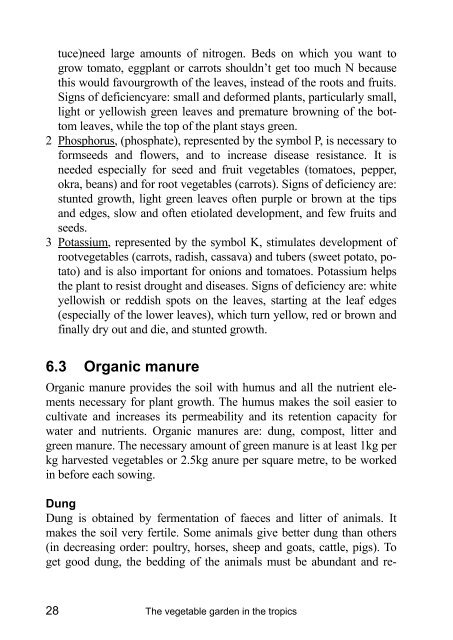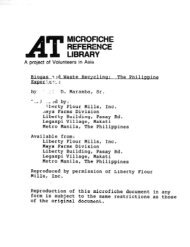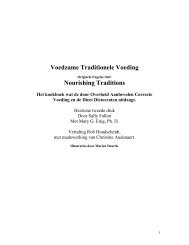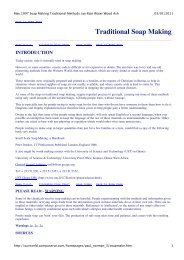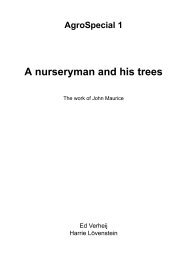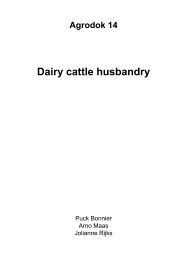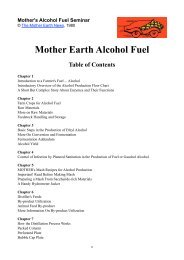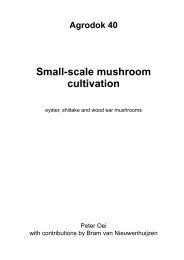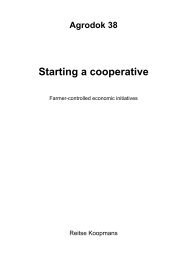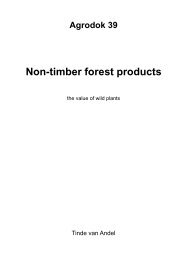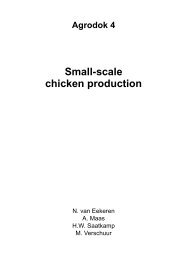The vegetable garden in the tropics - Journey to Forever
The vegetable garden in the tropics - Journey to Forever
The vegetable garden in the tropics - Journey to Forever
You also want an ePaper? Increase the reach of your titles
YUMPU automatically turns print PDFs into web optimized ePapers that Google loves.
tuce)need large amounts of nitrogen. Beds on which you want <strong>to</strong><br />
grow <strong>to</strong>ma<strong>to</strong>, eggplant or carrots shouldn’t get <strong>to</strong>o much N because<br />
this would favourgrowth of <strong>the</strong> leaves, <strong>in</strong>stead of <strong>the</strong> roots and fruits.<br />
Signs of deficiencyare: small and deformed plants, particularly small,<br />
light or yellowish green leaves and premature brown<strong>in</strong>g of <strong>the</strong> bot<strong>to</strong>m<br />
leaves, while <strong>the</strong> <strong>to</strong>p of <strong>the</strong> plant stays green.<br />
2 Phosphorus, (phosphate), represented by <strong>the</strong> symbol P, is necessary <strong>to</strong><br />
formseeds and flowers, and <strong>to</strong> <strong>in</strong>crease disease resistance. It is<br />
needed especially for seed and fruit <strong>vegetable</strong>s (<strong>to</strong>ma<strong>to</strong>es, pepper,<br />
okra, beans) and for root <strong>vegetable</strong>s (carrots). Signs of deficiency are:<br />
stunted growth, light green leaves often purple or brown at <strong>the</strong> tips<br />
and edges, slow and often etiolated development, and few fruits and<br />
seeds.<br />
3 Potassium, represented by <strong>the</strong> symbol K, stimulates development of<br />
root<strong>vegetable</strong>s (carrots, radish, cassava) and tubers (sweet pota<strong>to</strong>, pota<strong>to</strong>)<br />
and is also important for onions and <strong>to</strong>ma<strong>to</strong>es. Potassium helps<br />
<strong>the</strong> plant <strong>to</strong> resist drought and diseases. Signs of deficiency are: white<br />
yellowish or reddish spots on <strong>the</strong> leaves, start<strong>in</strong>g at <strong>the</strong> leaf edges<br />
(especially of <strong>the</strong> lower leaves), which turn yellow, red or brown and<br />
f<strong>in</strong>ally dry out and die, and stunted growth.<br />
6.3 Organic manure<br />
Organic manure provides <strong>the</strong> soil with humus and all <strong>the</strong> nutrient elements<br />
necessary for plant growth. <strong>The</strong> humus makes <strong>the</strong> soil easier <strong>to</strong><br />
cultivate and <strong>in</strong>creases its permeability and its retention capacity for<br />
water and nutrients. Organic manures are: dung, compost, litter and<br />
green manure. <strong>The</strong> necessary amount of green manure is at least 1kg per<br />
kg harvested <strong>vegetable</strong>s or 2.5kg anure per square metre, <strong>to</strong> be worked<br />
<strong>in</strong> before each sow<strong>in</strong>g.<br />
Dung<br />
Dung is obta<strong>in</strong>ed by fermentation of faeces and litter of animals. It<br />
makes <strong>the</strong> soil very fertile. Some animals give better dung than o<strong>the</strong>rs<br />
(<strong>in</strong> decreas<strong>in</strong>g order: poultry, horses, sheep and goats, cattle, pigs). To<br />
get good dung, <strong>the</strong> bedd<strong>in</strong>g of <strong>the</strong> animals must be abundant and re-<br />
28<br />
<strong>The</strong> <strong>vegetable</strong> <strong>garden</strong> <strong>in</strong> <strong>the</strong> <strong>tropics</strong>


